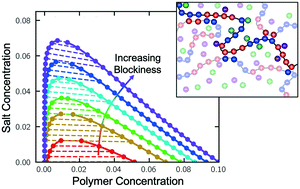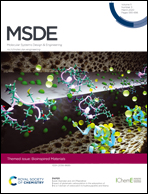Sequence-dependent self-coacervation in high charge-density polyampholytes
Abstract
Polyampholytes, which contain both positive and negative charges along the backbone, represent a classical model system for certain types of ‘intrinsically-disordered proteins’ (IDPs). IDPs can possess biological functionality, even in an unfolded state, including the formation of phase-separated regions within a cell; while driven by a number of interactions, electrostatic attractions are thought to be key to forming these structures. This process of electrostatically-driven liquid–liquid phase separation, known as ‘complex coacervation’, can also be observed in simpler polymer or biopolymer systems. In this paper, we use a series of model polyampholytic polypeptides of increasing blockiness, that undergo ‘self-coacervation’ due to charge attraction between polycation and polyanion blocks along the same polymer chain. We show that these polypeptides undergo complex coacervation when sequences have at least 8–12 adjacent like-charges, with increasing blockiness leading to a larger two-phase region. We simultaneously develop a theory built on the transfer-matrix formalism developed by the authors, to show how blockiness increases the strength of electrostatic interactions and subsequently promote phase separation. We explore a tradeoff that emerges due to the presence of ‘charge-pattern interfaces’ where the sequence of polyampholyte charges switches sign, and how these contrast with chain-ends in equivalent homopolyelectrolyte coacervates.

- This article is part of the themed collection: Bioinspired Materials


 Please wait while we load your content...
Please wait while we load your content...
